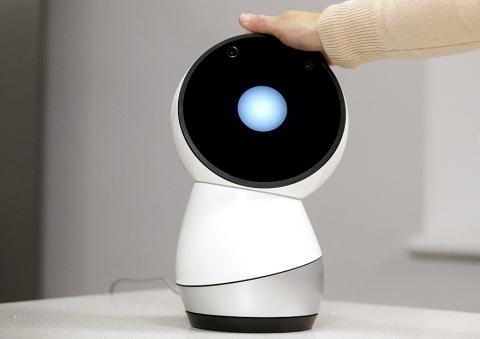When a robot “dies,” does it make you sad? For lots of people the answer is “yes,” and that tells us something important, and potentially worrisome, about our emotional responses to the social machines that are starting to move into our lives.
For Christal White, a 42-year-old marketing and customer service director in Bedford, Texas, that moment came several months ago with the cute, friendly Jibo robot perched in her home office. After more than two years in her house, the 30.5cm-tall humanoid and its inviting, round screen “face” had started to grate on her. Sure, it danced and played fun word games with her children, but it also sometimes interrupted her during conference calls.
White and her husband had already started talking about moving Jibo into the empty guest bedroom upstairs. Then they heard about the “death sentence” Jibo’s maker had levied on the product as its business collapsed.

Photo: AP
News arrived via Jibo itself, which said its servers would be shutting down, effectively lobotomizing it.
“My heart broke,” she said. “It was like an annoying dog that you don’t really like because it’s your husband’s dog, but then you realize you actually loved it all along.”
The Whites are far from the first to experience this feeling. People took to social media this year to say teary goodbyes to the Mars Opportunity rover when NASA lost contact with the 15-year-old robot.
A few years ago, scads of concerned commenters weighed in on a demonstration video from robotics company Boston Dynamics in which employees kicked a dog-like robot to prove its stability.
Smart robots such as Jibo obviously are not alive, but that does not stop us from acting as though they are.
Research has shown that people have a tendency to project human traits onto robots, especially when they move or act in even vaguely human-like ways.
Designers acknowledge that such traits can be powerful tools for connection and manipulation.
That could be an especially acute issue as robots move into our homes — particularly if, like so many other home devices, they also turn into conduits for data collected on their owners.
“When we interact with another human, dog or machine, how we treat it is influenced by what kind of mind we think it has,” said Jonathan Gratch, a professor at the University of Southern California who studies virtual human interactions. “When you feel something has emotion, it now merits protection from harm.”
The way robots are designed can influence the tendency people have to project narratives and feelings onto mechanical objects, said Julie Carpenter, a researcher who studies people’s interaction with new technologies.
Especially if a robot has something resembling a face, its body resembles those of humans or animals, or just seems self-directed, like a Roomba robot vacuum.
“Even if you know a robot has very little autonomy, when something moves in your space and it seems to have a sense of purpose, we associate that with something having an inner awareness or goals,” Carpenter said.
Such design decisions are also practical, she said, adding that our homes are built for humans and pets, so robots that look and move like humans or pets will fit in more easily.
However, some researchers worry that designers are underestimating the dangers associated with attachment to increasingly lifelike robots.
For instance, long-time artificial intelligence (AI) researcher and Massachusetts Institute of Technology professor Sherry Turkle is concerned that design cues can trick us into thinking some robots are expressing emotion back toward us.
Some AI systems already present as socially and emotionally aware, but those reactions are often scripted, making the machine seem “smarter” than it actually is.
“The performance of empathy is not empathy,” she said. “Simulated thinking might be thinking, but simulated feeling is never feeling. Simulated love is never love.”
Designers at robotic start-ups insist that humanizing elements are critical as robot use expands.
“There is a need to appease the public, to show that you are not disruptive to the public culture,” said Gadi Amit, president of NewDealDesign in San Francisco.
His agency recently worked on designing a new delivery robot for logistics company Postmates Inc — a four-wheeled, bucket-shaped object with a cute, if abstract, face; rounded edges; and lights that indicate which way it is going to turn.
It is likely to take time for humans and robots to establish a common language as they move throughout the world together, Amit said, adding that he expects it to happen in the next few decades.
Yet, what about robots that work with children? In 2016, Dallas, Texas-based start-up RoboKind introduced a robot called Milo designed specifically to help teach social behaviors to children who have autism. The mechanism, which resembles a young boy, is now in about 400 schools and has worked with thousands of children.
It is meant to connect emotionally with children at a certain level, but RoboKind cofounder Richard Margolin has said that the company is sensitive to the concern that children could get too attached to the robot, which features human-like speech and facial expressions.
So RoboKind suggests limits in its curriculum, both to keep Milo interesting and to make sure children are able to transfer those skills to real life. Children are only recommended to meet with Milo three to five times a week for 30 minutes each time.

DIVIDED VIEWS: Although the Fed agreed on holding rates steady, some officials see no rate cuts for this year, while 10 policymakers foresee two or more cuts There are a lot of unknowns about the outlook for the economy and interest rates, but US Federal Reserve Chair Jerome Powell signaled at least one thing seems certain: Higher prices are coming. Fed policymakers voted unanimously to hold interest rates steady at a range of 4.25 percent to 4.50 percent for a fourth straight meeting on Wednesday, as they await clarity on whether tariffs would leave a one-time or more lasting mark on inflation. Powell said it is still unclear how much of the bill would fall on the shoulders of consumers, but he expects to learn more about tariffs

NOT JUSTIFIED: The bank’s governor said there would only be a rate cut if inflation falls below 1.5% and economic conditions deteriorate, which have not been detected The central bank yesterday kept its key interest rates unchanged for a fifth consecutive quarter, aligning with market expectations, while slightly lowering its inflation outlook amid signs of cooling price pressures. The move came after the US Federal Reserve held rates steady overnight, despite pressure from US President Donald Trump to cut borrowing costs. Central bank board members unanimously voted to maintain the discount rate at 2 percent, the secured loan rate at 2.375 percent and the overnight lending rate at 4.25 percent. “We consider the policy decision appropriate, although it suggests tightening leaning after factoring in slackening inflation and stable GDP growth,”

Meta Platforms Inc offered US$100 million bonuses to OpenAI employees in an unsuccessful bid to poach the ChatGPT maker’s talent and strengthen its own generative artificial intelligence (AI) teams, OpenAI CEO Sam Altman has said. Facebook’s parent company — a competitor of OpenAI — also offered “giant” annual salaries exceeding US$100 million to OpenAI staffers, Altman said in an interview on the Uncapped with Jack Altman podcast released on Tuesday. “It is crazy,” Sam Altman told his brother Jack in the interview. “I’m really happy that at least so far none of our best people have decided to take them

PLANS: MSI is also planning to upgrade its service center in the Netherlands Micro-Star International Co (MSI, 微星) yesterday said it plans to set up a server assembly line at its Poland service center this year at the earliest. The computer and peripherals manufacturer expects that the new server assembly line would shorten transportation times in shipments to European countries, a company spokesperson told the Taipei Times by telephone. MSI manufactures motherboards, graphics cards, notebook computers, servers, optical storage devices and communication devices. The company operates plants in Taiwan and China, and runs a global network of service centers. The company is also considering upgrading its service center in the Netherlands into a